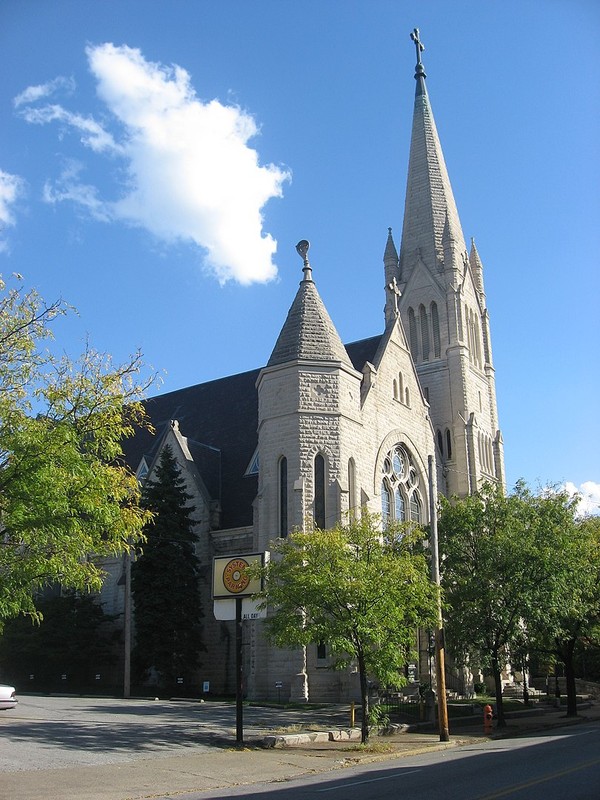Calvary Episcopal Church,
Introduction
Text-to-speech Audio
Images
Front and northern side of Calvary Episcopal Church, located at 821 S. Fourth Street in Louisville, Kentucky,

Backstory and Context
Text-to-speech Audio
Calvary Episcopal Church, designed in the Victorian Gothic Revival style, exists as one of many historic churches erected during the nineteenth century on 4th Street and throughout the Old Louisville area. One of the nation's only two cut stone spires caps the south tower, which rises 250 feet in height. The church emerged at a time when Louisville's "Southern Extension" (now referred to as Old Louisville) came into existence as one of Louisville's first suburbs, mainly catering to the wealthy who chose to move away from the congested downtown region. Several grand homes arose in the 1870s and 1880s; a boom in church construction coincided with that housing boom.
The Episcopal Church in Kentucky evolved slowly, starting in 1775 with a service provided by Rev. Lytle (or Lisle), a Church of England clergyman. Occasional services occurred from time to time, but formal efforts to organize the Episcopal Church transpired decades later, notably in 1829 with the establishment of The Diocese of Kentucky and three parishes. In 1831, Louisville supported sixty-one communicants. In 1860, the members of the congregation of Sehon Methodist Church seceded from the Methodist Church. They were accepted into the Episcopal Church and continued to meet in the Sehon Chapel until 1872 when the Reverend W. H. Platt inspired the vestry to undertake a new, larger church at a new location at Fourth Street between York and Breckinridge.
The church commissioned W. H. Redin, a prominent local architect with a reputation for ecclesiastical designs. Like most of the buildings constructed in Old Louisville during the late nineteenth century, it enjoyed fine architecture with a Victorian design. The architect had to design the church in two phases, the first involving construction of the sanctuary and part of the nave and the second phase concerning the remainder of the nave and the main West front. The first phase commenced in 1872 and finished in 1876. However, the McDonald Brothers completed the second phase much later (1885 - 1889) and have their name on the church's cornerstone, but the group followed Redin's designs.
Cite This Entry
Powers, Mathew. " Calvary Episcopal Church,." Clio: Your Guide to History. April 9, 2021. Accessed April 17, 2025. https://theclio.com/entry/130409
Sources
Calvary Episcopal Church. Accessed April 9, 2021. https://www.calvaryepiscopal.org/.
Garr, Robin. "Old Louisville: America's Victorian Neighborhood." Great American Country. greatamericancountry.com. Accessed April 9, 2021. https://www.greatamericancountry.com/places/local-life/old-louisville-americas-victorian-neighborhood
Langsam, Walter E. "Nomination Form: Calvary Episcopal Church." National Register of Historic Places. nps.gov. 1977. https://npgallery.nps.gov/NRHP/GetAsset/NRHP/78001347_text
Marsteller, Duane. "Calvary Episcopal Church." The Historical Marker Database. hmdb.org. December 3, 2020. https://www.hmdb.org/m.asp?m=161372
Wickenden, Homer E. "History of the churches of Louisville with special reference to slavery." Electronic Theses and Dissertations. Paper 1564. 1921. https://doi.org/10.18297/etd/1564. Another digital copy can be found through the University of Louisville Library at https://ir.library.louisville.edu/cgi/viewcontent.cgi?article=2563&context=etd.
By Nyttend - Own work, Public Domain, https://commons.wikimedia.org/w/index.php?curid=22565004

